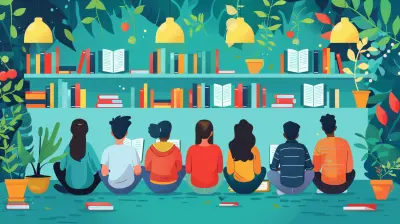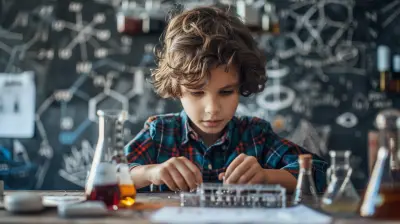Art as a Tool for Mindfulness in the Classroom
3 June 2025
In today's fast-paced, high-stress educational environment, students are constantly bombarded with information, deadlines, and social pressures. It's no wonder many struggle with anxiety, lack of focus, and burnout. But what if there was a simple, effective way to bring more calm and focus into the classroom? Enter art as a tool for mindfulness.
Art has long been associated with self-expression and creativity, but its benefits extend far beyond that. It can serve as a powerful mindfulness tool, helping students stay present, reduce stress, and improve their overall well-being. In this article, we'll explore how incorporating art into the classroom can foster mindfulness, boost student engagement, and create a more positive learning environment.

What is Mindfulness, and Why Does It Matter?
Mindfulness, in simple terms, is the practice of being fully present and engaged in the moment. It involves paying attention to thoughts, emotions, and surroundings without judgment. When applied in the classroom, mindfulness can help students:- Improve focus and concentration
- Reduce stress and anxiety
- Enhance emotional regulation
- Boost creativity and problem-solving skills
- Strengthen interpersonal relationships
With the growing emphasis on student mental health, mindfulness has become a widely accepted strategy to help learners navigate the challenges of academic and personal life. And one of the most engaging ways to cultivate mindfulness? Through art.

How Art Promotes Mindfulness
Art and mindfulness go hand in hand. When students create art, they immerse themselves in the process, allowing their minds to slow down, focus, and relax. Unlike traditional meditation, which can be challenging for some students, art provides an accessible and enjoyable way to practice mindfulness.Here’s how art fosters mindfulness in the classroom:
1. Encourages Focus and Presence
When students engage in artistic activities—whether painting, drawing, sculpture, or even doodling—they become deeply absorbed in the process. This state of flow keeps them present in the moment, calming wandering thoughts and reducing distractions.Think about it—have you ever lost track of time while coloring or sketching? That’s mindfulness in action!
2. Reduces Stress and Anxiety
Art has a natural calming effect. The rhythmic movement of a paintbrush, the gentle strokes of a pencil, or the smooth blending of colors can be incredibly soothing. This is why many therapists use art therapy as a tool for mental health treatment.In a classroom setting, incorporating art as a daily practice, even for just a few minutes, can help students unwind, process emotions, and release built-up stress.
3. Boosts Self-Expression and Emotional Awareness
Sometimes, students struggle to put their thoughts and feelings into words. Art provides a nonverbal outlet for them to express emotions they might not otherwise share. Whether it's through abstract painting, journaling with doodles, or sculpting from clay, students can visualize their feelings, leading to greater emotional awareness and self-acceptance.4. Promotes a Growth Mindset
Art teaches students to embrace imperfections and focus on the process rather than the outcome. Unlike math or science, where there's often a "right" answer, art encourages exploration and creativity.When students let go of perfectionism and simply enjoy creating, they build resilience, patience, and confidence—all essential skills that extend beyond the classroom.
5. Encourages Non-Digital Breaks
Let’s face it—students today are constantly glued to screens. Whether it's laptops, tablets, or smartphones, digital overload is a real problem.Art provides a much-needed tech-free zone, allowing students to disconnect from screens and reconnect with themselves. This digital detox can significantly improve mental clarity, reduce eye strain, and enhance overall well-being.

Simple Ways to Integrate Art for Mindfulness in the Classroom
You don’t need to be an art teacher or have fancy supplies to introduce mindful art into your classroom. Here are a few simple, beginner-friendly ways to incorporate art as a mindfulness tool:1. Mindful Coloring
Coloring isn't just for kids—it's a fantastic way to practice mindfulness! Provide students with mandalas or intricate designs and encourage them to focus on the colors, patterns, and strokes as they fill them in.2. Freeform Doodling
Give students a blank sheet of paper and let them doodle freely for a few minutes. No rules, no expectations—just pure creative expression. This practice helps clear the mind and reduce stress.3. Nature-Inspired Art
Take students outside and ask them to sketch or paint something from nature. Observing and replicating natural elements like leaves, flowers, or landscapes encourages mindfulness by drawing attention to detail and appreciation for the environment.4. Emotion-Based Art Exercises
Ask students to paint or draw their emotions using colors, shapes, and textures. For instance, if they’re feeling happy, they might use bright yellows and playful strokes. If they’re stressed, they might opt for darker shades and chaotic lines. This helps students connect with their emotions in a meaningful way.5. Collaborative Art Projects
Group art activities, such as creating a class mural or a collage, can foster social connection, teamwork, and mindfulness at the same time. Working together on an artistic project encourages students to stay present and engaged while building stronger relationships with their peers.6. Clay or Playdough Sculpting
Sculpting with clay or playdough is a tactile, hands-on experience that can be incredibly grounding. The act of molding, shaping, and smoothing the material helps students engage their senses and focus solely on the task at hand.7. Art and Gratitude Journals
Encourage students to keep a visual journal where they can draw, paint, or collage things they’re grateful for. Practicing gratitude through art reinforces positivity and mindfulness in daily life.
Final Thoughts
Incorporating art as a mindfulness tool in the classroom is a simple yet powerful way to help students reduce stress, improve focus, and enhance emotional well-being. In a world that often prioritizes academic achievement over mental health, bringing creativity into learning can create a healthier, happier, and more engaged classroom environment.So, why not give it a try? Even a few minutes of mindful art each day can make a profound difference in your students' overall well-being. Whether it's coloring, sketching, or sculpting, these small artistic moments can lead to big improvements in focus, relaxation, and emotional resilience.
all images in this post were generated using AI tools
Category:
Art EducationAuthor:

Olivia Lewis
Discussion
rate this article
3 comments
Astoria Kelly
Embracing art in the classroom transforms learning into a mindful journey. It nurtures creativity, enhances focus, and fosters emotional well-being, empowering students to express themselves and connect deeply with their surroundings. Let the colors flow!
June 14, 2025 at 7:30 AM

Olivia Lewis
Thank you for your insightful comment! I completely agree—art truly enriches the learning experience and nurtures both creativity and emotional well-being.
Alanna McGuire
Art fosters mindfulness in the classroom, enhancing focus, creativity, and emotional well-being among students.
June 14, 2025 at 4:23 AM

Olivia Lewis
Thank you for highlighting the vital role of art in promoting mindfulness! It truly enhances students' overall well-being and creativity.
Elidi Rios
Creative expression enhances mindfulness, fostering focus and emotional well-being in students.
June 4, 2025 at 2:46 AM

Olivia Lewis
Thank you for your insightful comment! I completely agree—creative expression truly plays a vital role in fostering mindfulness and overall emotional well-being in students.



